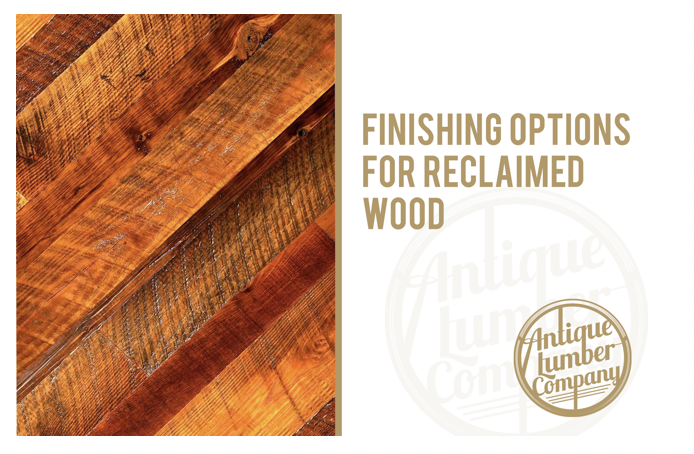
Finishing Options for Reclaimed Lumber
A reader reached out to us to ask “what’s the best finishing option for antique lumber? The answer to this is based on personal preference as well as carefully determining what the piece will be used for. At Antique Lumber Company, we have a passion for the natural and weathered patina that’s characteristic of our aged pieces. While options like painting and staining work fine on antique wood, it masks the beauty that has taken so many years to achieve. For this reason, applying a clear finish is recommended. Here are 4 options for finishing a piece of antique lumber while still preserving its natural –
Clear Coats
There are essentially 4 types of clear-coat products – polyurethane, polyacrylic, varnish, and shellac. Here is where things get tricky… All polyacrylic is polyurethane-based, but polyurethane contains no polyacrylic. Confused? Let’s take a closer look:
Polyurethane
Polyurethane is a polymer (large molecule) substance suspended in carbamate (urethane.) In simple terms, it’s a liquid-based plastic that yields good results as a finishing agent. It comes in 2 varieties, water and oil-based. Both come in a variety of sheens like glossy and satin finishes, but that’s where their similarities end.
Water-based polyurethanes are low in toxicity and odor, a definite plus when working indoors. They also have the advantage of not discoloring the wood piece like their counterpart. While it is quick to dry, it is less immune to the rigors of sunlight and water.
Oil-based polyurethane, on the other hand, is superior to water-based in that it can withstand high heat and prolonged exposure to direct sunlight. However, it takes longer to cure and therefore has a long drying time. It has a considerably higher VOC content (volatile organic compounds), and its user must apply it in only well-ventilated areas. It can also leave an amber tint to the wood you’re working with.
Polyacrylic
Polyacrylic is a water-based, oil-modified polyurethane. This means it’s a hybrid-form of polyurethane and offers some distinct advantages – it’s low odor makes it ideal for working in unventilated spaces, and it’s easily cleaned up with just soap and water. It dries quickly to the touch, although it still takes a bit of time to cure completely. Polyacrylic can be applied by brush or sprayed onto the wood’s surface making it a versatile choice. It leaves a crystal-clear finish when applied correctly and therefore doesn’t leave an amber-tint that oil-based finishes leave behind. One of the only disadvantages to using polyacrylic is that it has proven to be less effective in protecting surfaces that are exposed to high heat.
Varnish
People often use “varnish” interchangeably with other top coats; however, this is a misnomer. Varnish is made of alkyd resin, oil, and solvents and has been used to protect the wood of ships for over two centuries. It’s an excellent option for weatherproofing and sun protection. It’s one of the leading products for use on decks and outdoor furniture for this reason. It is, however, similar to polyurethane in that it can leave your wood with a vaguely yellow hue, so be advised.
Shellac
Shellac is a versatile, non-toxic wood finish that enhances the natural grain while adding smoothness without the plastic-like qualities of polyurethane or lacquer. It comes in the form of flakes of resin that are secreted by the lac bug native to India and Thailand. The flakes are dissolved in alcohol and are easily applied with a brush. It offers the option of a clear finish and can be tinted as well. The drawback to shellac is that it’s not best suited for every piece – you should avoid it for projects that will need to withstand extreme temperatures and pieces that require superior durability like tables and floors. That being said, it’s an excellent option for those wishing to use natural products.
Antique Lumber Company invites you to shop the finest selection of antique pine in Texas. Our warehouse is located just an hour north of the DFW Metroplex, and we’ve recently added Saturday hours for your shopping convenience. When you’re looking to bring quality and history to your home or business’ construction project, look no further than longleaf pine and Antique Lumber Company!



No Comments